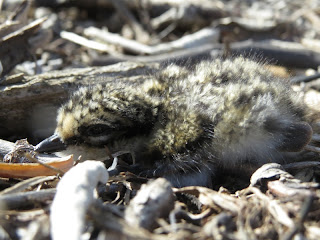Stilt Sandpipers were often heard doing their display high in the sky. However, we only managed to find 1 nest, and a predated nest. Stilt Sandpipers tend to sit tight on their nests when approached by a human and only slowly walk off their nest from less than 10 metres away! Not all shorebirds behave the same way. Whimbrels, for example, flush from over 100 meters away and won't return to their nest until you're well away from their territory.
Long-billed Dowitchers were uncommon in our area. We never did find any of their nests, but near the end of our stay we saw flocks of 40+ at all of our study locations. These were presumably birds that failed to nest and were getting ready to migrate South after a short stay in the Arctic.
Wilson's Snipe were very common in the air, but characteristically secretive when they were on the ground. We didn't find any of their nests, although we never really searched the appropriate habitat.
Semipalmated Plovers were found on all of the abandoned gravel pads that we checked. These gravel pads were built in the 70's or 80's when drilling took place in the area. On "our" gravel pad (the pad where we camped) we found 4 nests. However, 2 of those nests are from the same pair because they lost their nest for some unknown reason half-way through incubation. Most of the SEPL's were banded before we got there indicating that they have strong nest site fidelity. The fact that they were banded allowed us to keep track of individuals. One sly male was incubating two nests during the same time period!!
One of our survey areas was in the uplands of one of the islands. The altitude is high enough such that the area doesn't flood and, as a result, the habitat was completely different. It was more like the tundra one would expect of the arctic, with many wildflowers. American Golden-Plovers (AMGP) preferred these areas and we did find 1 of their nests.
Despite their abundance during migration further South, there were not many Least Sandpipers (LESA) breeding in our area. We only found 1 nest in the tundra habitat.
This LESA, however, managed to maintain a nest on our gravel pad without our knowledge until the chicks hatched! This is the second year in a row that a LESA has done this at that location.
Here's the LESA keeping a watchful eye over her chicks:
LESA chick:
LESA chick wing. The flight feathers are still growing within their sheath.
Only 1 Red Phalarope was seen during our stay. This female was feeding in a regularly searched area on June 17. It was presumably already on its southbound migration.
Long-billed Dowitchers were uncommon in our area. We never did find any of their nests, but near the end of our stay we saw flocks of 40+ at all of our study locations. These were presumably birds that failed to nest and were getting ready to migrate South after a short stay in the Arctic.
Wilson's Snipe were very common in the air, but characteristically secretive when they were on the ground. We didn't find any of their nests, although we never really searched the appropriate habitat.
Semipalmated Plovers were found on all of the abandoned gravel pads that we checked. These gravel pads were built in the 70's or 80's when drilling took place in the area. On "our" gravel pad (the pad where we camped) we found 4 nests. However, 2 of those nests are from the same pair because they lost their nest for some unknown reason half-way through incubation. Most of the SEPL's were banded before we got there indicating that they have strong nest site fidelity. The fact that they were banded allowed us to keep track of individuals. One sly male was incubating two nests during the same time period!!
SEPL chicks are very cute :)
One of our survey areas was in the uplands of one of the islands. The altitude is high enough such that the area doesn't flood and, as a result, the habitat was completely different. It was more like the tundra one would expect of the arctic, with many wildflowers. American Golden-Plovers (AMGP) preferred these areas and we did find 1 of their nests.
Despite their abundance during migration further South, there were not many Least Sandpipers (LESA) breeding in our area. We only found 1 nest in the tundra habitat.
This LESA, however, managed to maintain a nest on our gravel pad without our knowledge until the chicks hatched! This is the second year in a row that a LESA has done this at that location.
Here's the LESA keeping a watchful eye over her chicks:
LESA chick:
Only 1 Red Phalarope was seen during our stay. This female was feeding in a regularly searched area on June 17. It was presumably already on its southbound migration.
Here's the female Hudsonian Godwit that we banded with a satellite transmitter. Maybe you'll see XY somewhere out there!
Always keeping a watchful eye:





















